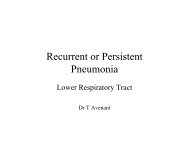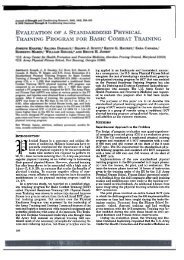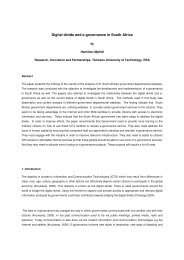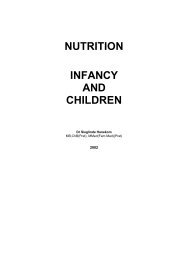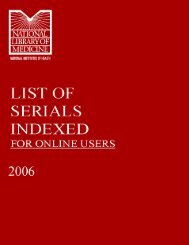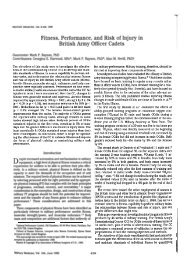Research and Training Strategies for Goat Production Systems in ...
Research and Training Strategies for Goat Production Systems in ...
Research and Training Strategies for Goat Production Systems in ...
Create successful ePaper yourself
Turn your PDF publications into a flip-book with our unique Google optimized e-Paper software.
Perspectives on the constra<strong>in</strong>ts, opportunities <strong>and</strong> issues surround<strong>in</strong>g research on<br />
goat production <strong>in</strong> Southern Africa<br />
PB Cronje<br />
Department of Animal & Wildlife Sciences, University of Pretoria<br />
Pretoria 0002, South Africa<br />
The resolution of issues (i.e. questions or disputes) represents the only valid motivation <strong>for</strong><br />
research (the endeavour to discover facts by study or <strong>in</strong>vestigation), <strong>and</strong> is the cornerstone<br />
<strong>for</strong> the null-hypothesis upon which the scientific method is based. The impact <strong>and</strong> usefulness<br />
of research f<strong>in</strong>d<strong>in</strong>gs will, there<strong>for</strong>e, be determ<strong>in</strong>ed by the relevance of the issue that is<br />
addressed. Un<strong>for</strong>tunately, <strong>in</strong> many cases far too little time is spent def<strong>in</strong><strong>in</strong>g what the critical<br />
issue is. Because of ill-def<strong>in</strong>ed perceptions of what the relevant issues actually are, it is not<br />
unusual to f<strong>in</strong>d that entirely disparate perspectives exist with regard to research priorities. It<br />
is not the <strong>in</strong>tention of this paper to add to the list of research priorities, but rather to def<strong>in</strong>e<br />
some of the issues that may or may not be relevant as departure po<strong>in</strong>ts <strong>for</strong> the prioritisation<br />
of research related to goat production <strong>in</strong> South Africa.<br />
For the purposes of this paper, it is accepted that the ultimate issue that should be addressed<br />
by goat research should be the quality of life of all the peoples of South Africa. The term<br />
>quality of life= <strong>in</strong>cludes social, economic <strong>and</strong> biological dimensions. The dimension most<br />
frequently addressed by animal scientists is that of biology, <strong>and</strong> with<strong>in</strong> this context the issue<br />
most frequently used as a departure po<strong>in</strong>t <strong>for</strong> prioritisation of animal science research is that<br />
of food production.<br />
South Africa is reasonably self-sufficient <strong>in</strong> terms of the amount of food of animal orig<strong>in</strong><br />
that is produced <strong>and</strong> consumed on a per capita basis. Although the relative consumption of<br />
different types of meat has changed over the last 35 years, the total per capita consumption<br />
of meat has rema<strong>in</strong>ed constant despite a substantial population growth. In addition to this,<br />
with the exception of beef, the real prices of all animal products have either decl<strong>in</strong>ed<br />
(poultry, pork, milk, eggs) or rema<strong>in</strong>ed relatively constant (mutton) over the last 29 years<br />
(Nieuwoudt, 1998). If greater food production is the real issue, research priorities should be<br />
directed towards <strong>in</strong>creas<strong>in</strong>g the output <strong>and</strong> efficiency of <strong>in</strong>tensive animal production<br />
systems. The advances <strong>in</strong> productivity have been achieved over the past 30 years can be<br />
ma<strong>in</strong>ly attributed to the mass-production of anabolic hormones <strong>and</strong> their use to <strong>in</strong>crease<br />
growth <strong>and</strong> milk production rates, as well as improved genetic selection methods. In the<br />
future, further improvements <strong>in</strong> productivity are likely to be achieved us<strong>in</strong>g gene<br />
technologies which would allow critical genes to be switched on or off as desired, <strong>and</strong> also<br />
by the clon<strong>in</strong>g of genetically modified animals (Etherton, 1998). While these technologies<br />
may represent appropriate research priorities <strong>for</strong> the more developed countries, it is wise to<br />
consider whether the issue be<strong>in</strong>g addressed is applicable to South Africa.<br />
In the past, research priorities <strong>in</strong> South Africa have been dom<strong>in</strong>ated by ef<strong>for</strong>ts to <strong>in</strong>crease<br />
food production <strong>and</strong> per capita consumption. However, an <strong>in</strong>creas<strong>in</strong>g appreciation of the<br />
fact that 5.8% of the population account <strong>for</strong> over 40% of total consumption has lead to the<br />
adoption of food security (i.e. the access of all people to enough food <strong>for</strong> a healthy <strong>and</strong><br />
active life) as a more appropriate issue <strong>for</strong> research prioritisation than food production.<br />
S<strong>in</strong>ce some 30% of the population of South Africa are classified as the ultra-poor (i.e. those<br />
do not obta<strong>in</strong> sufficient food) <strong>and</strong> of these, 80% are blacks liv<strong>in</strong>g <strong>in</strong> rural areas, it is<br />
2








